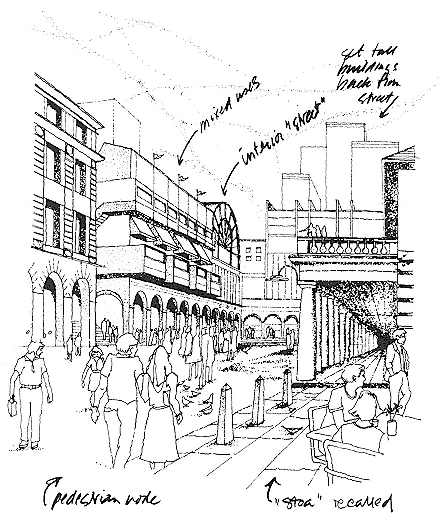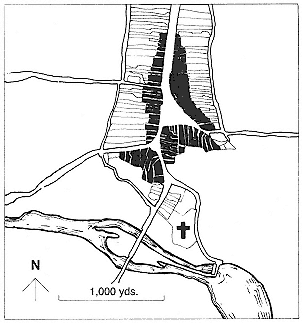The Humanist Stance
The humanist position is not as clearly and comprehensively formulated as the functionalist. Rather, it is a collection of intentions, techniques, and design ideas offered by a diverse group of proponents. It emerged in the 1950s and 1960s not as a new theory but as a reaction to the unsatisfactory results of functionalist thinking and design. Among those representing humanist attitudes were the British townscape school, disaffected CIAM members who took the name Team 10, and certain Dutch architects.[*]
Although both functionalist and humanist approaches are responsive to needs, the former begins at the macro scale, with zoning for industry, housing, and so forth and necessary transport connections, whereas the latter begins by examining the impact of small-scale elements on day-to-day experiences:
[*] Kenneth Browne, Gordon Cullen, and Thomas Sharp are most closely associated with townscape values, the concern for richness and responsiveness in small-scale urban environments. Team 10 included Alison Smithson, Peter Smithson, Aldo van Eyck, Georges Candillis, and Jacob Bakema. The Dutch architects with humanist/structuralist inclinations include Herman Hertzberger and Aldo van Eyck.

9.
An ideogram for humanist urban design recalls the drawings of Gordon Cullen and
Kenneth Browne. Humanist qualities are suggested in the visual variety, attention to
small scale, depiction of people engaged in activities, and annotations through which
the designer "scripts" the place. From a drawing by Kenneth Browne,
published in West End (London: Architectural Press, 1971).
Make a welcome of each door
a countenance of each window.
Make of each a place; a bunch of places of each house and each city
(a house is a tiny city, a city a huge house).[14]
Functionalist planning imposes a structure upon the city, whereas humanist planning seeks to realize and enhance preexisting and underlying social structures. Land-use diagrams are typical illustrative techniques for functionalist schemes; a humanist design is more likely to be described with a set of sequential drawings depicting a user's perception of the place and conveying a variegated visual character or with a diagram of behavioral patterns.
For those whose first concern is the human experience of the city and its social life, the good city is best understood as a collection of enclaves not unlike villages. These are shaped by and reflect the individuals and groups who inhabit them. Humanist designers expect the inhabitants of a city to "appropriate" the environment and make it their own; they believe that the city should not be a fait accompli but that people should specify and help to create what they want. Self-help and reliance on neighbors are better than dependency on a centralized government: "The more somebody is personally able to influence his surroundings, the more involved and attentive he becomes, and also the more likely he will be to give them his love and care. What we offer cannot be neutral; it must be the raw material, as it were, containing the 'intentions' out of which everyone can make his own choice in a particular situation, extracting from it precisely the intention which 'resonates' with his intentions."[15] In other cases where the design task is more complicated, an advocate intervenes on behalf of users to improve what producers offer.
Decisions are based on users' needs and circumstances rather than on concepts: "The best way to plan for downtown is to see how people use it today; to look for its strengths and to exploit and reinforce them. There is no logic that can be superimposed on the city; people make it, and it is to them, not buildings, that we must fit our plans."[16] Decision making tends to be incremental rather than set by a master plan. Insofar as centralized planning is needed, its goal should be to "catalyze" and "nourish" rather than to direct: "The science of city planning and the art of city design, in real life for real cities, must become the science and art of catalyzing and nourishing . . . close-grained working relationships."[17]
Whereas on the small scale inhabitants mold the city in a multitude of ways as they pursue myriad personal visions, at the larger scale there are meaningful "monuments" that represent an enduring shared heritage, neither transient nor personal. Acknowledging this difference, Dutch humanist architects distinguish between special buildings of enduring character and everyday architecture that serves the immediate needs and desires of the populace. For them the city thus both reflects the evolving requirements of its inhabitants and testifies to timeless cultural values and patterns. Present and past intertwine. For Aldo van Eyck, "the time has come to bring together the old into the new; to rediscover the archaic principles of human nature."[18]
The humanist urban designer pays attention to small-scale elements and informal ordering systems, avoiding large-scale, superimposed geometries. Design in human scale achieves familiarity and the sense that things have been made by and for people. Van Eyck affirms the importance of fitting architecture to the people who inhabit it; the mission of architecture, in other words, is to assist in man's homecoming.[19]
Humanist designers, moreover, advocate a mixed use of the urban environment. Functional zoning and functional distinctions are not the norm; instead, activities and elements overlap and are interwoven so the "drama is released."[20] For example, whereas functionalist streets are principally for automobiles, humanist streets are domesticated and become
"livable" places "for people."[21] "In the suburbs and slums the vital relationship between the house and the street survives, children run about, . . . people stop and talk, dismantled vehicles are parked, . . . you know the milkman, you are outside your house in your street. . . . Streets [should] be places and not corridors or balconies. Thoroughfares where there are shops, post boxes, telephone kiosks."[22] When traffic hazards, noise, and pollution are controlled on these streets, the pavements become a stage for the theater of neighborhood life.[23] Urban character comes from a rich mix, what Jane Jacobs calls "organized complexity."
Humanists believe that the future city need not differ much from the present one insofar as the present one is satisfactory. Any changes that are needed will be patterned more often on elements of existing neighborhoods and districts than on new concepts. In effect, tradition is a sourcebook of these elements that were thrown out or ignored by functionalist design, which sought to invent a new and different future. Humanist urban design finds lessons in the past, among them specific borrowable features that make places visually more appealing and more congenial: kiosks, bollards, granite pavers, benches, and so forth. Humanist designers also borrow from vernacular traditions such qualities and patterns as market squares, passages, and clustered housing. Because they suspect direct imitation and worry about pastiche and phoniness, humanist urban designers translate borrowed ideas from the past into modern terms whenever possible. Humanists like Aldo van Eyck complain that "modern architects have been harping continually on what is different in our time to such an extent that even they have lost touch with what is not different, with what is always essentially the same."[24]

10.
A traditional village mixes uses at a human scale and thus
is a model for humanist design.
Based on a plan in Maurice Beresford,
New Towns of the Middle Ages (London: Lutterworth, 1967).
Whereas a functionalist urban designer might conceive of the urban center as a place for the impersonal exchange of goods and information and thus design it to be efficient for this process, the humanist designer sees the center as enhancing the human experience of these activities. Intimacy and richness of experience must go hand in hand with efficiency. The urban center is not so much a tool of commerce as a richly variegated composite of experiences. Designers must consider "what makes a city center magnetic, what can inject the gaiety, the wonder, the cheerful hurly-burly that make people want to come into the city and to linger there. For magnetism is the crux of the problem. All downtown's values are its by-products. To create in it an atmosphere of urbanity and exuberance is not a frivolous aim."[25]
Critics say that humanists do not consider the large-scale issues and overall needs of the city. Although houses may be designed at the grass roots, housing is a system that needs a comprehensive perspective and approach. The incremental planning that characterizes the humanist method can create problems in the workings of the larger urban system. And the design-by-committee approach inherent in humanist theory slows down improvement and makes conflict inevitable. The future of cities is too complex a task for the naive and the untrained.
The efforts of the humanist designer to achieve small-scale familiarity often result in pastiche. In appealing to the senses, such a design often fails the mind. It focuses on perceived surfaces and neglects and devalues deeper concepts.[26] In short, it can be little more than scenographic.